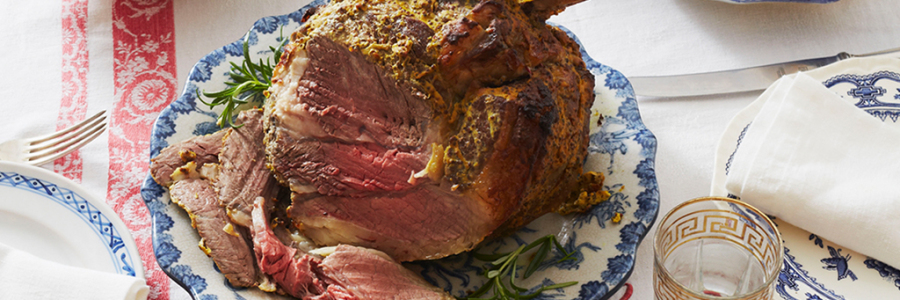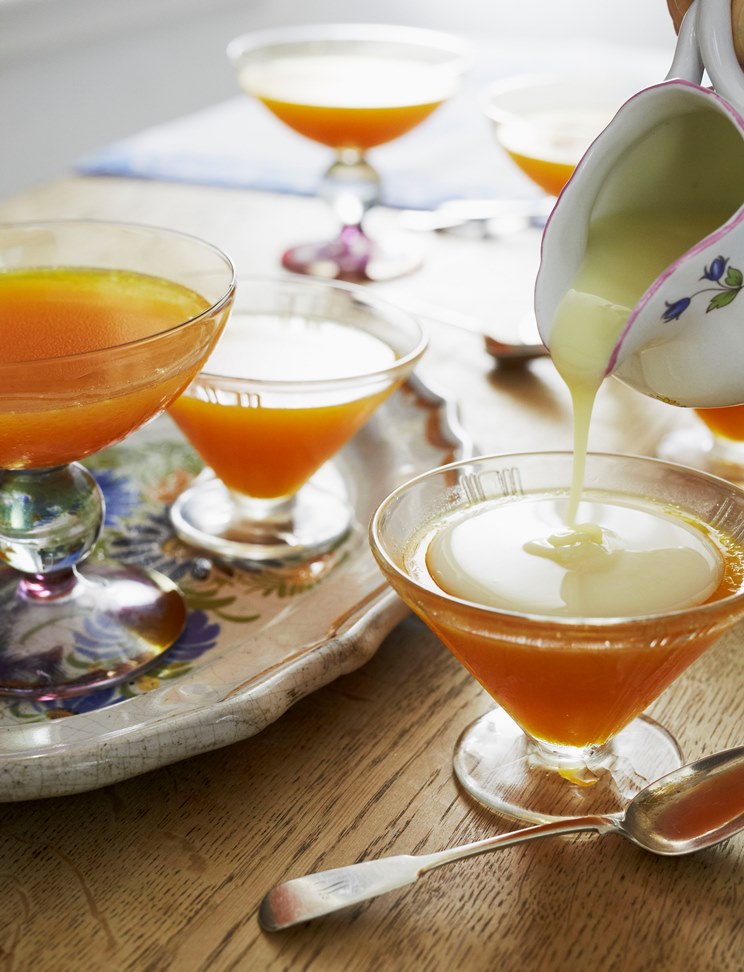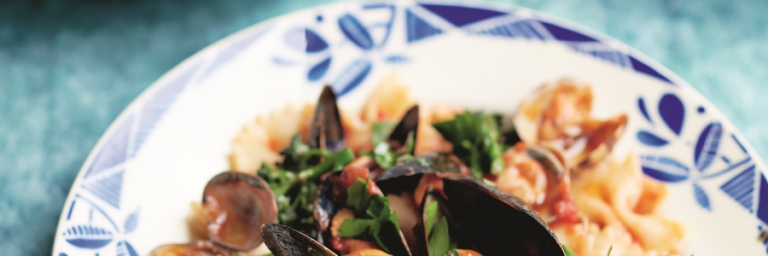Cook a three-course-meal with Kirstie Allsopp

Looking for weekend cooking inspiration? Join Kirstie in the kitchen for a three-course meal!

Starter: Tabbouleh
My first experience of Middle Eastern food was at Maroush in Beauchamp Place: their Jawaneh chicken wings are something else. When I did my history of art course at Christie’s, I used to go to a nearby Lebanese kebab shop every day for my lunch. That was when I fell in love with tabbouleh, an affair that continues.
Many recipes for tabbouleh use a Middle Eastern spice mix, such as baharat (which can include allspice, black pepper, cardamom, cassia, cloves, coriander, cumin, nutmeg and chilli), or Lebanese seven-spice mix (paprika, pepper, cumin, cassia, cloves, coriander, cardamom and nutmeg), but you can mix your own. Simply use a pinch each of coriander, cinnamon, ginger, cloves and nutmeg, or any of the spices mentioned above, to make a teaspoonful of flavouring.
Serves 4
25g bulgur wheat
50 ml boiling water
300g ripe tomatoes
2 large bunches of flat-leaf parsley
small bunch of mint
6 spring onions
3 tbsp lemon juice
4 tbsp extra virgin olive oil
1 tsp mixed ground spices (see introduction above)
salt and freshly ground black pepper
TO SERVE
at least 8 small Romaine or Little Gem lettuce leaves
4 ready-made flatbreads
Put the bulgur wheat in a small bowl and add the boiling water. Stir, then set aside for 20 minutes, or until the water has been absorbed. Drain in a sieve to be sure.
Meanwhile, use a sharp knife to remove the calyx and hard core from the tomatoes. (You can also skin the tomatoes and remove the seeds if you like, but I don’t usually bother.) Quarter what’s left, then cut into dice and put into a large serving bowl.
Pick the parsley and mint leaves, discarding the stalks or saving them for a stock. Chop the leaves finely, and do the same to the spring onions. Add them all to the tomatoes and mix well. When the bulgur wheat has absorbed all the water, use a fork to fluff it up and separate the grains. Add it to the tomatoes.
Drizzle the lemon juice and olive oil into the tomato mixture and season to taste with salt, pepper and your chosen spices. Mix well.
To serve, arrange the lettuce and flatbreads on 4 serving plates. Offer the tabbouleh in its bowl and ask people to help themselves, scooping tabbouleh into the leaves.

Main Course: Roast rib of beef with a mustard crust
This beef has been a winner in our family ever since James Mackenzie – of the Pipe & Glass Inn in East Yorkshire – cooked it for one of my TV series. He was also the one who famously taught me to cook the accompanying Yorkshire Puddings (see page 00). I have roasted this beef for Sunday lunch, and occasionally for Christmas Day lunch. It is an expensive cut, so you don’t want it to go wrong, and with this recipe, it won’t. I love the idea of a ‘trellis’ of vegetables keeping the meat above the surface of the pan and allowing air to flow around the joint. The vegetables add enormous flavour to the rich gravy as well.
Serves 8–10
2.5–2.6kg forerib of beef (about 2 ribs)
Rapeseed oil
2 carrots, washed and roughly chopped
1 onion, peeled and roughly chopped
1 leek, washed and roughly chopped
1 celery stick, washed and roughly chopped
2 tbsp English mustard paste
3 tbsp Dijon mustard
2 tbsp wholegrain mustard
FOR THE MULLED WINE GRAVY
rapeseed oil, for frying
2 large onions, peeled and sliced
500ml homemade mulled wine or red wine
red wine vinegar (optional)
2 tbsp plain flour
1 litre beef stock (a stock cube is fine)
2 tbsp redcurrant jelly
salt and freshly ground black pepper
Preheat the oven to 220°C/Fan 200°C/Gas 7. Put a roasting tray inside to heat up.
Sear the joint in the hot roasting tray on top of the stove, using a little of the oil, until golden brown all over. Transfer the beef to a plate.
Make a criss-cross arrangement of the vegetables in the roasting tray – this ‘trellis’ will serve as a rack for the meat.
Mix the three different types of mustard in a bowl and rub all over the meat.
Cover the exposed bones with foil.
Place the beef on the vegetables, cover the whole tray with foil and roast for 20 minutes. Remove the foil, reduce the temperature to 180°C/Fan 160°C/Gas 4 and continue roasting for a further 1½ hours (the meat will be medium rare).
Meanwhile, start the gravy. Put a little rapeseed oil in a large saucepan and fry the onions over a medium heat until soft and caramelised (about 20–30 minutes).
Add the mulled wine and bring to the boil over a high heat. Taste and if you find it too sweet, add a touch of red wine vinegar. Lower the heat and simmer for another 30 minutes.
When the meat is ready, remove it from the tray and leave it to rest, covered loosely with foil, for at least 20 minutes.
Pour the excess fat out of the roasting tray, but keep the roasted veg in it. Place the tray over the heat, add the flour and cook, stirring for 2 minutes. Pour in the beef stock and stir well, scraping up any crusty bits from the tray. Bring to the boil and simmer for 3–4 minutes. It should thicken up a little. Strain through a sieve into the pan of cooked onion and mulled wine, using the back of a spoon to get out as much flavour as possible out of the vegetables.
Stir the redcurrant jelly into the oniony gravy and check the seasoning.
Carve the meat and serve with roast or mashed potatoes (see pages 00–00), a simple green veg and the delicious gravy.

Dessert: Blood orange jelly
This is a blast from childhood, but I was recently reminded of the joys of jelly when my friend Magnus served me one for dinner. It’s so easy, and delicious.
That experience encouraged me to dig out my great-great granny’s recipe for jelly, which sounds so funny now: ‘Colour and flavour some common jelly with crème de menthe. When strawberries are in season, lay a foundation of big strawberries on a layer of strawberry ice. Cover with the jelly.’
In the old days, jelly would have been made in moulds, which I really love, but Ben says they don’t work, so I don’t buy them anymore. However, I do have an old plastic mould that used to belong to my mum. It is in the shape of a bunny rabbit – surely every household had one? – and jelly made in that is strictly for the family. For posher gatherings I make jelly in my vintage stemmed crystal bowls, which are perfect for lunch or dinner parties and fantastically kitsch.
The recipe below is completely straightforward, but you can add fruit if you like. Pour a little of the dissolved jelly into the dishes, let it set, then top with some chopped fruit and a little more dissolved jelly. Back in the fridge, and repeat this process until all the jelly and fruit are used up, and the dishes are full. Serve with ice cream or condensed milk. (The first time I gave my stepsons condensed milk, they told their mum they really liked the new kind of milk they’d had at Dad’s house, and she rang me to say she’d been trying for years to get them on to goat’s milk. I did eventually confess the truth.)
Serves 8
2 x 135g packets of orange jelly
450ml boiling water
600ml blood orange juice
Break the jelly into cubes and place in a large heatproof bowl. Pour in the boiling water and stir until the jelly has completely dissolved. (I use less water than suggested on the packet in order to make the blood orange flavour even stronger.) When the jelly is cold but not set, pour in the blood orange juice, give it a stir, then pour the mixture into your chosen mould(s). Put in the fridge or a cool place to set.
When ready, you could decorate each serving with a swirl of whipped cream, a spoonful of condensed milk and a pretty sweet biscuit stuck on top. If serving from a large mould, a scoop of ice cream would go well beside a spoonful or two of jelly.
Extracted from Kirstie’s Real Kitchen by Kirstie Allsopp, published by Hodder & Stoughton on 7th September, £25. Photography by Rita Platts © Hodder & Stoughton 2017.


